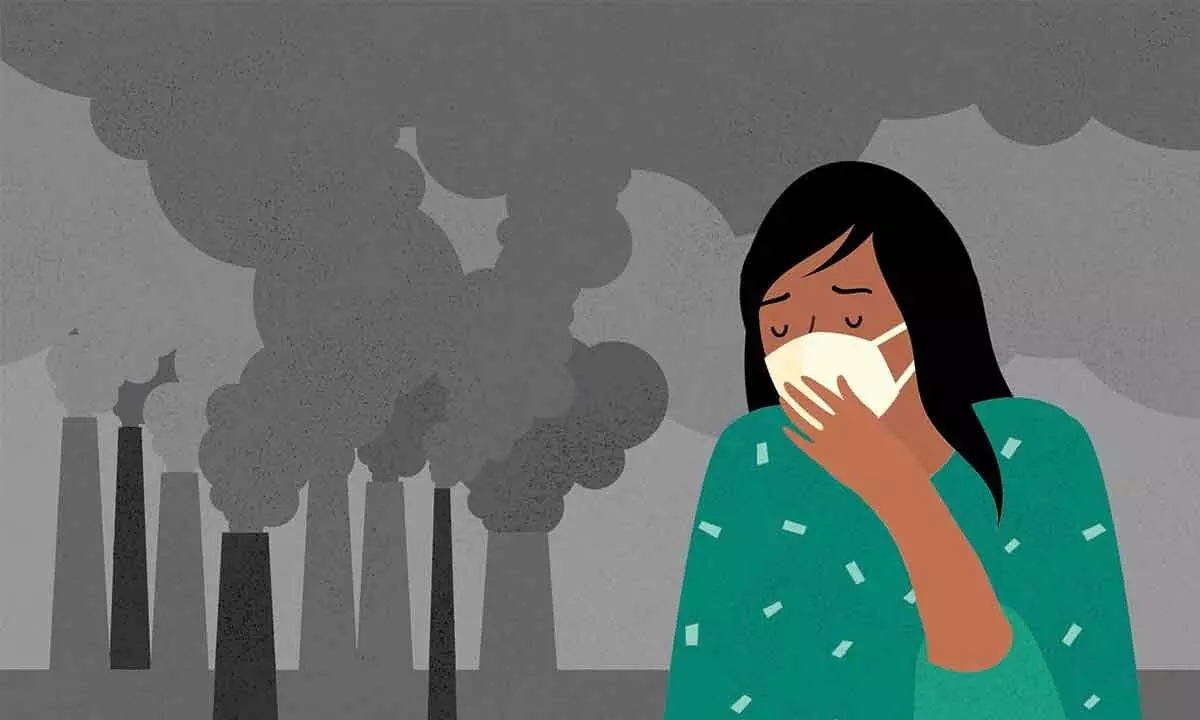Live
- Metro Railway Kolkata to evacuate stranded rakes from tunnels using battery power
- Controversy Over Congress President’s Remarks on Maha Kumbh Mela
- CM Urges H.D. Deve Gowda to Stand Above Politics for Karnataka’s Water Rights
- Unseeded Kyrian Jacquet upsets second seed Billy Harris to win Delhi Open 2025 singles title
- India headed to become $30-35 trillion economy in next two decades: Piyush Goyal
- Medical Students to Adopt Rural Families as NMC Pushes for Community-Based Learning
- Central Railway runs special trains, improves crowd management for Mahakumbh devotees
- Yamuna's cleaning drive in Delhi: PM Modi's pre-election promise now in action
- IPL 2025: LSG is a strong contender for the title, says Zaheer Khan after schedule’s release
- Maha Open: Ramanathan progresses to final qualifying round
Just In
Air pollution: A new cause for the rising diabetes rates in India?

Representational image
The prevalence of diabetes is rapidly increasing in India. According to the ICMR-INDIAB national study, there are currently 101 million people with diabetes and 136 million people with prediabetes in India today. These numbers are expected to further increase in the years to come.
New Delhi: The prevalence of diabetes is rapidly increasing in India. According to the ICMR-INDIAB national study, there are currently 101 million people with diabetes and 136 million people with prediabetes in India today. These numbers are expected to further increase in the years to come.
We have always known that there are marked urban rural differences in the prevalence of diabetes with urban areas having much higher prevalence rates.
Till now, it was believed that the higher prevalence in urban areas was due to greater affluence which led to unhealthier diets higher in calories, decreased physical activity and probably the stress associated with urban living.
However the recent CARRS study done at Chennai and Delhi funded by the NIH, has found a new link to Type-2 diabetes through an unexpected source -- air pollution.
It was seen that even after correcting for all the known confounders like family history of diabetes, obesity, diet and physical activity, air pollution was associated with new onset type 2 diabetes both at Delhi and Chennai.
So how does air pollution contribute to diabetes?
It is now known that air pollution can act as an endocrine disruptor. Thus, it can interfere with both insulin secretion from the pancreas as well as its action in the liver and muscle, the very defects which lead to diabetes, in the first place.
It is now known that a fifth of the burden of Type-2 diabetes (T2D) worldwide may be attributable to air pollution, with a larger share coming from ambient PM 2.5 and the rest from household air pollution.
With the growing socio-economic development worldwide, the detrimental health effects of air pollutants are receiving increased attention.
Air pollutants are broadly classified into gaseous pollutants and atmospheric particulates.
Gaseous pollutants include sulphur compounds, nitrogen compounds, carbon oxides, hydrocarbons, and halogen compounds and atmospheric particulates include total suspended particulates, inhalable particles (PM10), fine particulate matter (PM2.5), and ultrafine particulate matter.
Type 2 diabetes mellitus and air pollution are critical public health concerns worldwide.
Existing evidence supports an association between the risk of T2D and ambient air pollution exposure, especially for fine particulate matter pollution (PM2.5) and nitrogen dioxide (NO2).
The biological mechanisms underlying this association include immune activation, endoplasmic reticulum stress, central nervous system inflammation, and oxidative stress.
The recent study in India assessed the association of PM2.5 exposure, glycemic markers and incidence of Type 2 diabetes in two urban cities, viz., Delhi and Chennai and provides evidence linking short-term, medium-term and long-term exposure to PM2.5 and incident T2D.
The study assessed PM2.5 from locally developed high-resolution spatiotemporal models and showed a clear association between PM2.5 and incident diabetes.
The evidence offers guidance for developing and implementing population and region-specific policies aimed at lowering ambient air pollution in order to combat the high prevalence of diabetes.
So what can we do to prevent diabetes knowing the link between air pollution and diabetes?
Firstly, we should try to reduce pollution. We know the major sources of the air pollution are either burning of stubble by farmers, smoke from vehicles, industrial pollution, use of firewood or charcoal in ill ventilated kitchens or indiscriminate pollution during festivals like Diwali due to fireworks, etc.
All these are potentially preventable by legislation, education and governmental and non-governmental agencies. Wearing a mask as we did when we had Covid-19 is a very good way to prevent particulate matter entering our bodies through the nose or mouth.
This is, in fact, a golden opportunity to prevent not only respiratory diseases but also metabolic diseases like diabetes by reducing pollution. THE TIME FOR ACTION IS NOW!
(Dr. Mohan is Chairman & Chief of Diabetology, Dr. Mohan’s Diabetes Specialities Centre & President, Madras Diabetes Research Foundation, Chennai, India. He is also Head of MDRF-Hinduja Foundation T1D program.)

© 2025 Hyderabad Media House Limited/The Hans India. All rights reserved. Powered by hocalwire.com






